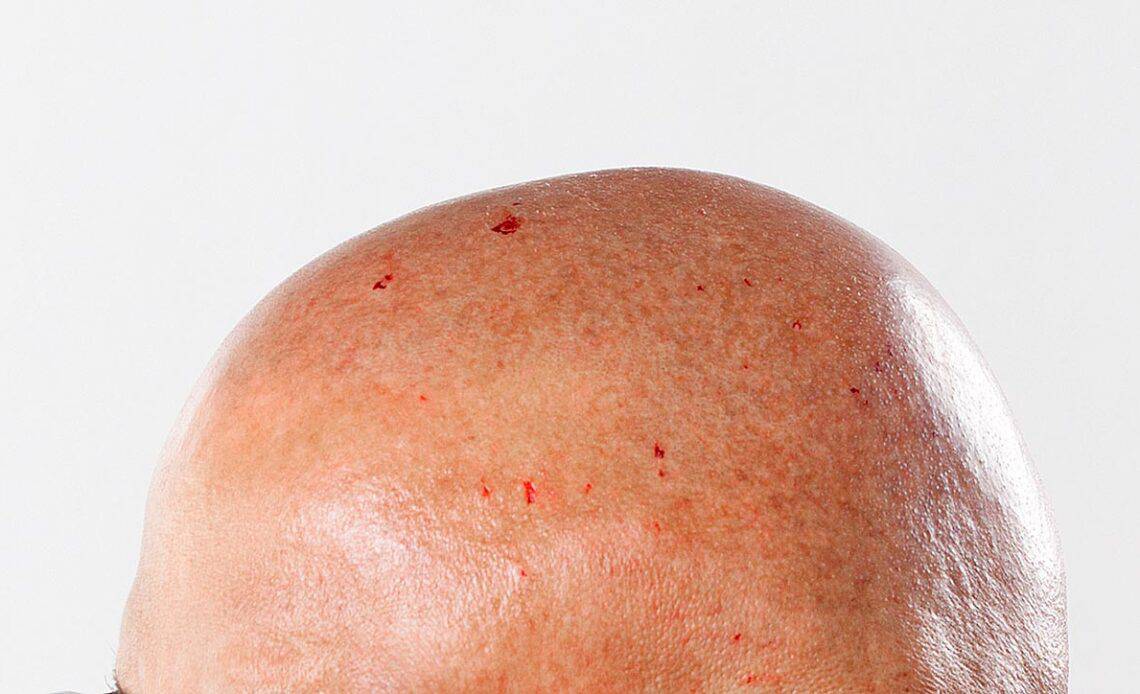
Above: My scalp, somewhat the worse for wear after my first shave with a single blade razor
BitDepth#1440 for January 08, 2024
It isn’t easy to move from a disposable multi-blade cartridge razor to a safety razor of any kind. And then, for the truly courageous, there’s the implied menace of the barber’s straight razor (Sweeney Todd anyone?).
Most multi-blade razors are designed to make shaving easier, but they wear out quickly, have a higher per blade cost and put lots of waste into the environment.
Shaving with a safety razor is just…different, but the first mistake that’s likely to draw blood is to underestimate the heft of a safety razor. These shaving tools aren’t built from the disposable materials used in cartridge razors.
Quality safety razors are usually made of solid metal and designed to last a lifetime. Some are chromed for old school styling, but most modern razors are made of machined and anodized aluminium.
That, coupled with the sharpness of a safety razor’s blade ensures a nick or two until you get used to handling them. My head was a bloody mess the first time I used one.
It’s tempting to give up here, because cartridge razor shaves make shaving both easy and accessible. All you have to give up is durability and a truly close shave.
Shaving, particularly if you are a head and face scraper, is a ritual that demands form and focus, not to mention new muscle memory.
Here’s how to tip your first experience with a safety razor in your favour.
Prepare your skin.
According to Ecliffe St Rose who trades as The Beardologist, “Proper prep is the key.”
“Washing your face with warm water and placing a warm towel (on the shaving area) helps in softening hair and opening pores.”
“It’s even recommended that shaving lather should also be applied warm and you should try to maintain that temperature throughout the shave.”
I wash all shave surfaces with a mild, neutral soap first (Pears, Neutrogena), then prepare the skin with a warm, clean cloth. I use a small white cotton towel that I soak in hot water.
I slowly massage the shave area with the cloth before draping it over my head like a floppy yarmulke.
Work the cream or shave soap to a lather with a shave brush. The brush isn’t necessary and I don’t use it when traveling, but once you’ve used one, you won’t ever want to shave without it.
My brush is a sable from Taylor of Old Bond Street that’s in its fourteenth year of continuous use. There are synthetics, but natural brushes last.
“You should know the direction your hair grows in and keep the skin surface lubricated throughout the process,” said St Rose.
“If you know you have an issue with bumps, we shave with the grade. Other than that, the first pass of the shave is with the grade (the direction your hair grows in) and the second pass against it, but we always reapply more shaving cream.”
With a safety razor, even with substantial grizzle, it’s possible to get a clean shave with a single pass of a safety razor in the direction your hair grows in, but I often do a second, reversing direction to clean up the back of my head, which I can’t see and which is, frankly, obzocky.

I keep a tiny notepad next to my shaving rig to record blade uses, because I can never remember where I am with the blade, and having a sense of the wear is useful. I average around 15 shaves before getting into diminishing returns.
If you only shave your face, expect much longer use from a single blade razor, 30 or more shaves at the very least.
Things that can go wrong.
A single edge razor is designed to reduce the need to touch the blade. The box of blades is both the injector mechanism and the storage for used blades.
If you’re not careful inserting the blade, it may not be seated flush and even the slightest misalignment of the blade will put it out of specifications and draw blood.
I now carefully inject the new blade (which also ejects the used blade), and then slightly loosen the clamping mechanism to confirm proper seating before tightening the guide shim.
Sometimes you get a rubbish blade. It’s mass produced. It’s not perfect. You won’t see any surface imperfections, but the blade just doesn’t feel right.
The more often you shave with a safety razor, the more intuitive you become about what the shaving process is supposed to feel like. I’ve encountered two crap blades out of more than a hundred. Dump the bad blade and load a fresh one.
The razor itself is no good. I’m a sucker for a tech pitch, so when a new razor project – the ironically named Hypebody Razor – showed up on Kickstarter (Supply also started there) promising a razor held together by neodymium magnets, I signed up.
It was a disaster, way more hype than razor. Creole hair fuzz quickly disassembled the unit during my first shave stroke on my scalp, and the loose blade carved a three-quarter inch flap of skin from behind my ear.
The makers fielded multiple complaints, promised a new guide clamp with stronger magnets. I tuned out and healed for a week.
Not exactly quietly but when you cuss out your own stupidity in whispers of ardent self-recrimination, no-one can hear you steam.
Your lather isn’t lathering. Shave lather is not bath lather. Shave soap (or cream) is not bath soap. They may look the same, but the blade, and more critically your skin, will quickly know the difference.
Try a quality shave soap or cream and you’ll never use one of those wasteful aerosol foam cans again. There’s a reason serious barbers never use them.
“A good quality soap or cream must have long lasting lather,” says St Rose, “I use Proraso, a brand from Italy.”





































